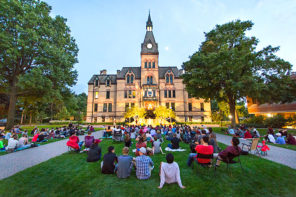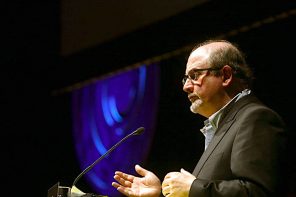Just over a year ago, I did an interview with Michael Muhammad Knight, and wrote a survey of his writing up until that time. He has a new book out, Why I Am a Five Percenter, which, while not as cohesive as his previous work, does again display the breadth and depth of his knowledge.
The first chapter introduces us to a brief history of the Five Percenters through his earlier engagement with the community in Harlem, particularly RZA, the hip-hop artist/producer affiliated with the Wu-Tang Clan. It seems appropriate. Knight deals with the ciphers, the hidden knowledge the Five Percent trade in. But this is also a knowledge that is extremely public via cultural production; it’s available, yet so many people miss it.
This metaphor of unrealized wisdom is a wonderful opening for the book. Knight continues, mixing academic musings with popular culture, and quoting Ebrahim Moosa on the stigma of associating with marginal groups. Knight has always been very good at representing the marginal, recognizing that it is always a question of perspective. The book is thus set up to speak for a community that is misrepresented because that knowledge is never quite understood. It also, and I think most importantly, about Knight’s own understanding about religion and religious belonging—although he doesn’t develop these ideas as fully as he did in his earlier work on the Five Percent.
In a chapter on racial theory, racism, and America’s changing notions of whiteness, Knight does a good job of cutting across disciplines, bringing sociological, legal, and genetic understandings of race into conversation. While I think some of his genetic arguments are overdetermined, in the context of the larger argument it is an impressive undertaking that ends with an important point: it does not matter how much we say race is a social construct, we still deal with the ramifications of racism every day.
The construction of whiteness here is crucial especially for Knight’s concerns regarding the Five Percent. The Nation of Islam held that the white man is the devil, and the Five Percent emerges out of NOI thought. If, according to Five Percenter thought, the black man is God, does that mean that Knight can ever belong? In the third chapter, Knight explores a long and convoluted history of white men within the Five Percent. He comes to the conclusion, tentatively, that he can belong—at least part of the time. These two chapters are Knight’s cri de coeur, as he strives to find a place in a place he thinks he may have a home.
Moving forward, Knight actively engages his own whiteness, and what it means to be a devil—metaphorically. It is set in the context of creating an American Islam and the impact of culture both in the formation of the NOI and the way Islam in America is expressed by Muslims. He also revisits some of his own work to demonstrate how his devilishness is expressed.
From racial definitions, Knight then turns to a discussion of religious ones. Chapter Five deals with the questions of who gets to define Islam. He delves into questions of the commodification and fetishization of religion. Ultimately, he argues that the Five Percent are not a religion; a position that members of the group claim as well. The community is not that structured, and it is based on a a a paradigm of self-awareness and engagement in the world—for each member of the Five Percent the designation means something different.
He buttresses these arguments in his seventh chapter, opening with Derrida and Ibn al-Arabi as figures who talk about the oceans of meaning in words. The flow of this overall argument is interrupted by an awkwardly placed chapter on women in the Five Percent. (The section itself is very strong, pointing out the tensions between seeking gender and racial equality, but seems to be in the wrong place in the book.)
Knight then returns us to his own personal quest to belong. He talks about Prince Allah, one of the earliest members of the Five Percent, who claimed to be both Sunni Muslim and a Five Percenter, the precise categories of belonging—mutually exclusive—that Knight is struggling with.
He concludes by talking about writing the work at Harvard and how he is making sense of it all in his own way.
Living at the Threshold
Like all his previous works, Why I am a Five Percenter is brimming with information. Unfortunately, I think the text needed a stronger editorial hand to make it flow together better. I am never quite sure if I am reading a follow-up Knight’s earlier work on the Five Percenters, a spiritual autobiography, or a discourse on the relationship amongst race, religion, and Islam in America.
Sometimes that ambiguity is useful, but more often than not, it’s confusing. I am also left with several questions about the text. Knight spends a great deal of time exploring the idea that W.D. Fard, founder of the Nation of Islam, was of South Asian descent. While I remain unconvinced of this, Knight marshals here and elsewhere, a broad array of evidence. Early on, he also actively discounts any potential evidence for an Arab background for Fard. However, at the end of the text, as he explores the intellectual precursors to the Five Percent, he most closely aligns them with Arab movements, which is where my sympathies lie.
I think he needs to address these competing ideas he puts forward more directly. He also talks about the fact that placing the Five Percent in a broader Islamic framework is a way to co-opt the community, instead of letting be an honest manifestation of an American Muslim understanding. But he never explains why he felt he had to dedicate a chapter situating the Five Percent in a broader Muslim history. I am glad he did, and I think it is necessary, because of the extensive impact Muslims have had in the United States. You cannot discount that cultural memory. There are one or two other places where he makes a statement early in the text, but then revisits the question indirectly and leads the reader to a different conclusion.
The one place where I see the ambiguity being an advantage to this work is in Knight’s own sense of belonging. In his chapter on Prince Allah, the idea of fluid religious identity is very strong. He is living in that liminal space, not crossing thresholds of belonging and closing the door. He walks back and forth, and the text conveys that sense of unsettledness. Intentionally or not, Knight forces the reader to think about how we define ourselves and how much agency we actually have in that process.




